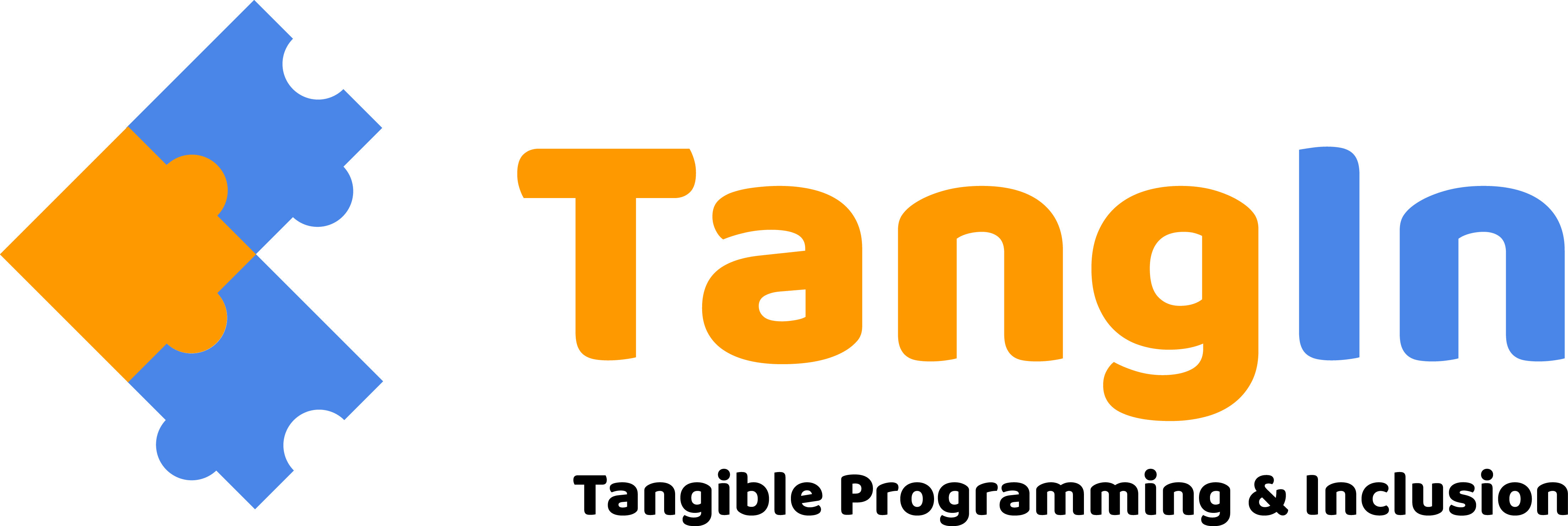Nota aclaratoria
Estas programaciones no se considerarán inmutables y estrictas, ya que los maestros tendrán la libertad de adaptarlos a la dinámica de su clase y explorar lo que consideran más relevante para sus alumnos. Las 21 programaciones iniciales fueron desarrolladas por el equipo de investigación de TangIn y probadas en el marco del proyecto en escuelas portuguesas, españolas, búlgaras y letonas.
Además de esto, los maestros que participan en la fase de evaluación han desarrollado nuevos planes de lecciones que se presentan a continuación.
01 | Introducción a la Programación
RESUMESUMMARY
Introduction to Computational Thinking, Programming and Robotics by using commands and role play dynamics. Simulate inputs and outputs and predict outcomes. Give examples of programming and algorithms in everyday life. Age group: all.
SUBJECTS
- Computational Thinking
- Robotics & Algorithms
02 | Introducción a MIGO
RESUMESUMMARY
MI-GO is a tool that embodies the tangible programming concepts. This session is aimed to the introduction of the story of MI-GO and the explanation on how it is programmed.
The first part of the session is dedicated to the customization of MI-GO where students use their imagination and art skills to build a character.
Students will also learn that the robot is programmed through the use of blocks and the function of each block. At the end of the session they will be able to execute simple instructions. Age group: all.
SUBJECTS
- Robotics & Algorithms
- Arts
03 | Características de los animals
RESUMESUMMARY
Animal cards scattered around a grid. Using the BOT to travel to them according to specific characteristics Age group: 6-10 years old
SUBJECTS
- Biology
04 | Cuadrado mágico
RESUMESUMMARY
Using the BOT to go to all squares without repeating in a chess board using only the knight movement while doing it building magic squares. Age group: 9-12 years old.
SUBJECTS
- Maths
- Operations
05 | Mapas y señales de tráfico
RESUMESUMMARY
Learn that maps are a representation of a reality on a different scale. Use coordinates to find the correct correspondence between the small and big scale.
Identify traffic signs and what they mean. Age group: 6-10 years old.
SUBJECTS
- Geography
- Math
06 | Minecraft
RESUMESUMMARY
Using the BOT to mine minerals in the correct sequence according to their properties. Age group: 8-12 years old.
SUBJECTS
- Natural Science
- Geology/minerals
07 | Multiplicación
RESUMESUMMARY
Multiplication Tables are not only about memory there is logic behind it, and fun also. With the BOT’s help we will build them by counting squares (areas). Age group: 7-9 years old.
SUBJECTS
- Maths
08 | Reciclaje
RESUMESUMMARY
Learn about the different types of waste and where they should be placed. Plastic, metal, glass and organic waste are valuable resources that must be reused and recycled.
With the help of the robot, students sort different types of waste and put it in the correct recycling bin. Age group: 6-10 years old.
SUBJECT
- Environment
- Society
09 | Simetría
RESUMESUMMARY
Finding the symmetry plan of geometrical figures drawn by MI-GO and divide in halves. Age group: 7-10 years old
SUBJECT
- Geometry
10 | Triángulos
RESUMESUMMARY
Locate and group different triangles in a geometrical figure drawn by MI-GO. Age group: 9-12 years old.
SUBJECTS
- Geometry
11 | Patchwork
RESUMESUMMARY
Areas puzzle. Rotating Tetris like pieces to see where they fit. Same puzzle requires team work of different groups to solve it. Age group: 9-12 years old.
SUBJECTS
- Mathematics
- Areas
12 | Sistema circulatorio
RESUMESUMMARY
Drawing the circulatory map, connecting organs while separating venous and arterial blood flows Age group: 7-9 years old.
SUBJECTS
- Biology
- Human Body
13 | Ángulos
RESUMESUMMARY
First introduction to angles, and distinguish between a right angle, acute and obtuse. Age group: 6-10 years old.
SUBJECTS
- Geometry
14 | Conectar puntos
RESUMESUMMARY
Same puzzle to train/introduce loops that increases gradually the level of complexity. Ideal to assess current level of proficiency. Age group: 8-12+ years old.
SUBJECTS
- Programming/loops
15 | Tren especial
RESUMESUMMARY
Activity to create circuits and time-tables using the solar system as theme. Age group: 6-10 years old.
SUBJECTS
- Solar system
- Logistics (time schedules)
16 | Ciclo del agua
RESUMESUMMARY
Competitive game with the water cycle as theme. Age group: 6-12 years old.
SUBJECTS
- Environment
17 | Palabras
RESUMESUMMARY
Scrabble like game using MI-GO to create words for a subject at choice. Age group: 6-12 years old.
SUBJECTS
- Multiple subjects
18 | Constelaciones
RESUMESUMMARY
Drawing constellations with MI-GO and using scaled cards/maps to measure angles and lengths and convert to the Set dimensions. Age group: 9-12 years old.
SUBJECTS
- Space
- Geometry
19 | Calculo
RESUMESUMMARY
Matching cards with basic arithmetic operations and numbers on the Set as possible solutions Age group: 8-10 years old.
SUBJECTS
- Mathematics
- Operations
20 | Paises de la UE (y banderas)
RESUMESUMMARY
Matching flag cards with countries and capitals. Age group: 6-10 years old.
SUBJECTS
- Society
- Geography
21 | Unidades de medida
RESUMESUMMARY
Using MI-GO to measure the classroom and use the data to create maps at scale. 8-10 years old.
SUBJECTS
- Physics
Matriz de TangIn
La siguiente tabla presenta una matriz de las programaciones de TangIn desarrolladas, relacionándolas con los respectivos grupos de edad que abordan, así como con temas educativos específicos.
Otras Programaciones
Además, puede consultar y usar otras cuatro programaciones desarrolladas por profesores Búlgaros y Letones (solo están disponibles en Inglés).
